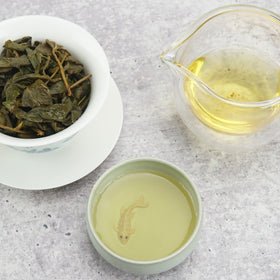
Celebrating Spring with Risheehat
Now that spring is here in all its glory, it is wonderful to sit outside and enjoy a cup of tea. This morning I sat in the backyard of our home with Risheehat First Flush 2014. Brewing it gong-fu style, I took in not just all the exquisite flavors from back home Darjeeling but also the beauty of spring that now surrounds us here.
This morning's cup of Risheehat unexpectedly became steeped in nostalgia and I missed my home in the hills. From our veranda in Darjeeling I could view the village of Risheehat on the opposite ridge. The tea garden itself runs down along a steep slope. As the crow flies Risheehat would be less than 10 minutes away from Darjeeling. But by road (broken as they are) Risheehat is a good hour and a half drive away.
At night the ridge is magically sequined with lights of the tea factory and the village. It is as if the stars have fallen from the sky - and into my cup.
As I pour hot water onto the tea in the gaiwan I can smell the freshness of spring rising. It is floral, green and sweet. Just like the spring air in the forests of Darjeeling.
The scent of the tea blends in with the sweet scent of the chokecherry tree flowers that hang low. For the three years we have been living in this house the tree has never bloomed this much. People are talking about how the abrupt rise in temperature has everything going at the same time. I don't mind.
I used a tablespoon of tea and let the first steep sit for only 30 seconds. A sweet floral fragrance wafts up as I open the gaiwan's lid. It amazes me how quickly the tea comes alive! Just like these flowers around me. In just a couple of weeks they popped out of what were just bare and wiry branches.
The second steep is for 40 seconds. I get peachy notes. The mouthfeel is luscious, yet crisp. There is a hint of astringency, but in perfect balance. Darjeeling first flush teas can be a bit brisk (term used for tea with astringent notes), which is considered desirable. It lends vitality to the tea.
The leaves are from chinary bushes - descendants of the original bushes brought from China nearly 200 years ago. These leaves are smaller than clonal or Assam cultivars. They tend to have a more delicate and floral character.
I am now on my third steep. A lingering sweetness coats my palate. It has a cooling effect in harmony with the morning air. I also enjoy an almond nuttiness.
I am not sure what the name Risheehat actually means. The present owners of the Risheehat tea garden think it stands for abode of the Rishis. Rishis are sages in Sanskrit. Back in the day, sages used to leave the humdrum of common life and retire to the forests for a life of reflection and other spiritual practices. But "hat" in the hills means market. So does Risheehat mean a market of sages?
Whatever it may be, for a while this morning Risheehat takes me away from the humdrum. After I am done with my tea ritual, I am ready for whatever the day brings. Cheers!
PS: View a video of my trip to Risheehat tea garden in 2012.










Leave a comment